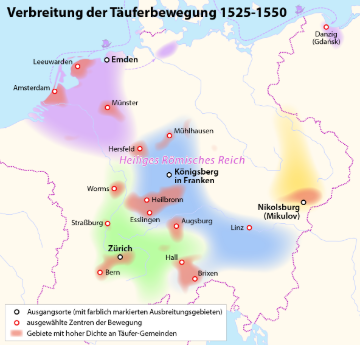Die Ausbreitung - The Spread
Despite persecution, Anabaptism spreads rapidly.

Author: Maximilian Dörrbecker (Chumwa), Wikipedia, licensed under Creative Commons CC BY-SA 2.0.
Three large Anabaptist groups emerge throughout Europe:
The "Swiss Brethren": They go back to the circle of former disciples and friends of Zwingli in Zurich, who practiced believer's baptism for the first time in 1525 and later spread mainly in the Swiss, Alsatian and southern German regions.
The Dutch and North German Doopsgezinde or Mennonites: After the end of the "Anabaptist Empire" in Münster, Westphalia, in 1535, Menno Simons is able to consolidate this group and commit it to a nonviolent course.
The Hutterites: They emerged from Anabaptist refugees in Moravia. Their most distinctive feature is the communitarian life on "Bruderhöfe" in community of labor and goods.
Characteristic features of these groups were:
- Community and fellowship.
- Biblical orientation, centered on the Sermon on the Mount
- Voluntary nature of faith and church membership
- Striving for "betterment of life"
- Distance from "authorities and the world”
- Renunciation of violence
Anabaptist nonconformism was apparent in the refusal to attend the official church, take the oath, and perform military service, as well as in innovative forms of helping one' s neighbors.



